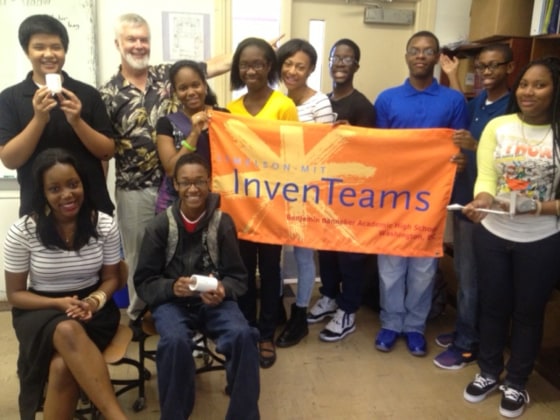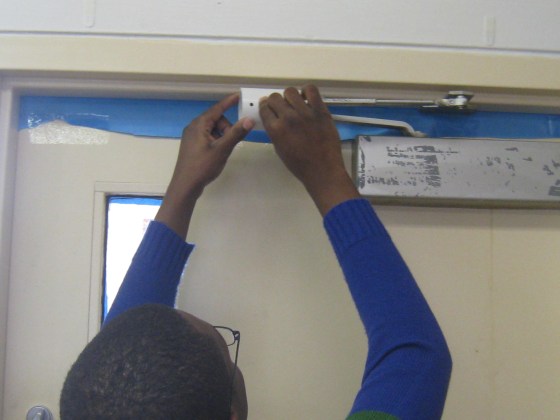Students, prompted by massacre, design emergency lock to thwart shooters
Oct. 24, 2013 at 5:05 AM ET

Benjamin Banneker High School
A team of high school students from Benjamin Banneker High School in Washington, D.C., is developing an emergency door-locking system to protect classrooms from active shooters. Pictured: Front row, left to right: Jennifer Omekan and James Poindexter; Back row: Jed Paolo Delatore, John F. Mahoney, Anjreyev Harvey, Chidinma Idika, Tiffani Lewis, Jide Omekan, Deonté Antrom, Khalonji Bulluck and Paprika Berry.
The killing spree at Sandy Hook Elementary School in suburban Connecticut last December sent a chill across America. If the unthinkable happened there, it could happen anywhere. The concern prompted a team of high school students in Washington, D.C., to design an inexpensive and effective emergency door-locking mechanism to prevent active shooters from entering their classrooms.
Like many schools around the country, the doors atBenjamin Banneker Academic High School lack classroom-side locks, a building code regulation leftover from a time when fire was the biggest threat to student safety. Unlockable doors mean students can escape a burning classroom quickly. Yet in today's world, students also worry about intruders coming into their classrooms and firing bullets.
"So many kids and adults were killed (at Sandy Hook). So we got together and we wanted to know how we could stop intruders from entering our school," Deonté Antrom, a junior at Benjamin Banneker, told NBC News.
Both Antrom and classmate Anjreyev Harvey, also a junior, have spent time working with younger kids in a nearby elementary school, so their reaction to the massacre was personal. "It is really troubling," added Harvey. "It was mostly our connection to kids that drove us to come up with this project."
"We decided to create something called a DeadStop," said Antrom.
Shut outThe device is designed to clasp around the closed arm-like hydraulic hinge at the top of the school's classroom doors (see image). An early prototype was made with PVC tubing that slips over the hinge and is held in place with a nail. But the pipe itself bent too easily, allowing the door to be opened enough for a shooter to stick a gun through the crack. A newer model will be more like a clamp.

Benjamin Banneker High School
An early prototype of the DeadStop was a piece of PVC tubing that was slipped over the hydraulic hinge of classroom doors. A newer model will be metal.
"It will be made of metal so it clamps on (the hinge)," Harvey told NBC News.
"The metal won't be able to bend. We will have a lock that is already made into it so you just clamp it on and it automatically locks. Therefore, it will be installed in just a second or so."
Harvey, Antrom and their teammates were awarded up to $10,000 in grant funding from the Lemelson-MIT InvenTeams Programearlier this month to help develop the locks. A law firm from Denver has already offered the team pro bono services to patent the invention. When completed, individual units should sell for between $10 and $15, cheap enough for wide adoption.
Most other emergency door-lock devices on the market require permanent attachment to the door frame, which could be maliciously triggered to, say, lock out a teacher who steps into the hallway for a second. These are also relatively expensive — costing about $35 a piece, according to the project team. Another device made of seatbelt webbing closes the hinge shut, but it too is expensive — about $50 — and permanently attached.
"The device we have is detachable. It will just be in the teacher's desk and when there is an announcement that there is a shooter in the building, they will be able to take it out and simply install it on the hinge," Harvey explained. "And how we have it designed, no matter how much the shooter shoots through the glass, or shoots at the hinge, he won't be able to open (the door)."
Fostering invention
This is the second year Benjamin Banneker has been selected to receive the Lemelson-MIT InvenTeams grant, which is designed to foster student skills in the areas of science, technology, engineering and math, the field known as STEM, and thus prepare them to make a social and economic impact with their future career choices.
This is the second year Benjamin Banneker has been selected to receive the Lemelson-MIT InvenTeams grant, which is designed to foster student skills in the areas of science, technology, engineering and math, the field known as STEM, and thus prepare them to make a social and economic impact with their future career choices.
In 2006, students from the school worked on an invention called Cell Mate, which was envisioned as a locker for cellphones, providing students a safe place to stash their mobiles and comply with school rules banning the gadgets from classrooms. A patent application for the invention was denied, noted John Mahoney, a math teacher at the school who leads the invention teams.
The DeadStop project, he told NBC News, also strikes a chord in the modern American psyche and he's hopeful it will find a home in the marketplace. But at the end of the day, he added, the InvenTeams "process is actually more important than the product — we are turning people on so they can make changes in their future."
John Roach is a contributing writer for NBC News. To learn more about him, visit his website.
No comments:
Post a Comment